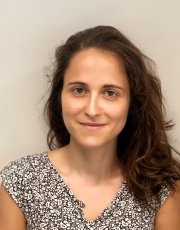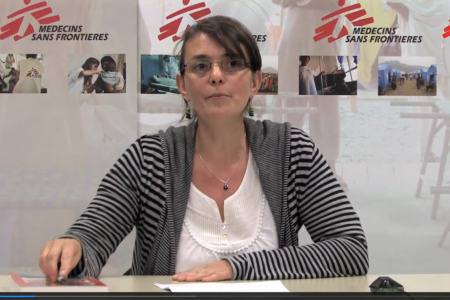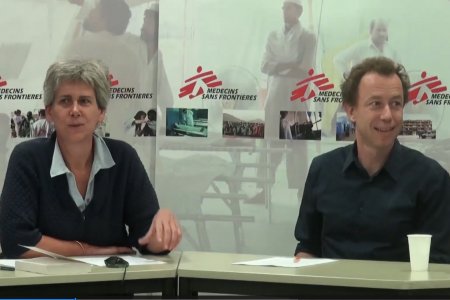Behind the scenes in the “natural" disaster community: a discussion with Sandrine Revet and Rony Brauman
Elba Rahmouni
To mark Editions MFSH’s publication of Les coulisses du monde des catastrophes « naturelles », on 14 November 2018, CERI (Centre de recherches internationales Sciences Po - CNRS) presented a discussion with its author, Sandrine Revet, CERI anthropologist and co-founder of the Association pour la recherche sur les catastrophes et les risques en anthropologie, and Rony Brauman. CRASH recommends this book to anyone with an interest in natural disasters and international relations.
Behind the scenes in the “natural” disaster community, a title that speaks volumes about the book
In this ethnography of the “natural” disaster community, Sandrine Revet studies only the social and political dimension of disasters, not their natural or physical aspects. Since the 1990s – and especially since the 2000s – there has been a change in thinking about disasters at the international level. Scientists – climate experts, seismologists, and others – have been joined by social science researchers, who analyse human activity’s role in rendering places and inhabitants vulnerable to such events. Hence the use of quotation marks in both the title and body of the book.
The community in question was created by multiple actors from a variety of fields (rescuers, NGO members, diplomats, scientists, etc.) as a governing body to deal with these so-called disasters. Studying the language, norms, narratives, and tools that form the dynamics of this international order, the author gives a detailed analysis of a community typically studied from a more comprehensive perspective. As Revet explains: “I chose the expression ‘disaster community' rather than ‘disaster government’ because it is above all a laborious construction process around disasters. It’s a social community in the interactionist sociology sense, always in the process of redefining itself and pushing its boundaries with other communities: climate, nuclear energy, humanitarianism…. I am trying to show how that community is constructed, rather than how it governs.”
Anthropology of a disaster. The 1999 mudslides in Venezuela
This second book is a follow-up to the earlier Anthropologie d'une catastrophe. Les coulées de boue de 1999 au Venezuela, an ethnographic investigation into the social, political and cultural dynamics of the 1999 "natural" disaster known as La TragediaAt the time of this disaster, the author was working for the NGO Enfants du Monde - Droits de l’Homme. She brings two-fold expertise to this book, as a humanitarian practitioner and a researcher.. In that book, Revet showed the various ways in which disaster is framed – for example, religious framing (God caused the disaster to punish men for their actions, and in particular for voting for Hugo Chavez) or what she calls natural-animist framing (the disaster was the result of wrathful Nature attempting to take back what is rightfully hers in the face of human invasion).
In contrast to the La Tragedia investigation, Revet’s study in Les coulisses du monde des catastrophes « naturelles » focuses on international actors, experts, elites, and modern institutions, rather than the populace experiencing the disaster. In the manner of American anthropologist Laura Nader (1961), she aims her examination higher (“studying up”).
CRASH invited Sandrine Revet to talk about her first book, Anthropologie d’une catastrophe. Les coulées de boue de 1999 au Venezuela, in 2010. Watch it at: “Living a Natural Disaster”.
The study and its conclusions: preparedness and resilience
Prolonged immersion in a milieu, reflexivity, learning the actors’ practices and language – as an anthropologist, Revet’s method is ethnography. Her study took more than seven years to complete. Her field sites included the UNISDR (United Nations Office for Disaster Risk Reduction) in Geneva, two Latin American sites (according to the author, “nodes that offered a view of that international community”), the Sendai conferenceThe Third UN Conference on Disaster Risk Reduction, held in March 2015., and the “virtual”Note that this virtual field site was the subject of a contemporaneous academic discussion on how to include it in research. field site made up of Facebook pages, online reports, etc. Revet also participated in that community as a member of a committee that reviewed UN documents, allowing her to attend numerous discussions around the choice of terms and definitions.
The study revealed two major frames used by disaster actors in their professional practice:
Preparedness. This is the idea that disaster is going to occur – it is not a risk or a probability, but a certainty, and so requires being proactive and determining what must be done when disaster does strike, by putting in place anticipatory and rescue measures. This frame – reflected in the use of disaster control vocabulary – is the basis for the development, for example, of a disaster preparedness market – both high tech and low tech (e.g.., survival backpacks to have at home for disaster prevention).
Resilience. In this frame, a natural disaster is a routinely-occurring phenomenon endogenous to the society. It therefore requires intervention at both the individual and collective levels to transform the society and adapt to the disaster. It carries the idea that a multitude of local practices, which necessitate individual participation, permits resilience and its corollary: a resilient community can do a lot for itself without outside help.
According to Revet, viewing “natural” disasters in these two ways is no obstacle to the constitution of a disaster community, the latter constantly demonstrating its capacity for consensus by absorbing and neutralising disagreement and contradiction.
Moreover, these frames are primarily political. Revet believes that the idea that the international arenas devoted to “natural disasters” are depoliticised is incorrect. “Just because there is a metric, a technique produced by experts, does not mean it is a depoliticised community. These frames are political visions of the world. Admittedly, it is complicated to say what those political visions are. The preparedness frame, for example, is itself vested with a number of political visions. One is that of the strong State, born after the Second World War. It is a kingly, military vision in which the State must stand ready. But that frame also has an individualist aspect, in which it is the individual who must prepare, stock provisions, etc.”
A humanitarian practitioner’s reading
According to Rony Brauman, Les coulisses du monde des catastrophes « naturelles » is a fascinating book offering both astute analyses of international actors and some “juicy dialogue”. Studying the actors who expect to govern the disaster community is a particularly interesting approach – one that could also be used for the humanitarian community.
The book has its lighter moments, as well. In it we learn that the various glossaries used by participants at these forums contain 128 definitions of “disaster”. It also gives a glimpse of the contradictions of a very hierarchical community that likes to see itself as egalitarian. At a conference in Peru, for example, the accommodations – and the system for picking up participants – mirrored the unwritten pecking order, with more important people enjoying nicer hotels and shorter trips.
Brauman explains that, like the international solidarity community, the international natural disaster community – the UN, in particular – tends to smooth over problems by seeking consensus at any cost. He cites the controversy after the 2004 tsunami, prompted primarily by World Health Organisation statements – despite all scientific evidence – on the risk of devastating epidemics. “We have known since Pasteur that spontaneous generation of microorganisms is a myth.” Those WHO statements amplified the influx of NGOs, which turned out to be a real burden for the Indonesian authorities and a huge waste of resources.
The disaster community began to take shape in 1971. “1971 was also the year of MSF’s birth as a result of two founding events: the Biafran War (1967-70) and the East PakistanNow Bangladesh.cyclone, the century’s deadliest, with approximately 300,000 deaths (1970). Government neglect – at a time when the eastern province was demanding independence – led to large-scale demonstrations whose suppression was so violent (causing hundreds of thousands of deaths and ten million refugees) it amounted to genocide. In our collective memory the disaster that struck East Pakistan – which became Bangladesh that year – is considered a natural disaster, not a massacre. It was a political event disguised as a natural disaster.”
Brauman observes that the disaster community described by Revet is built around the concept of emergency – that is, a sudden, transient event. Yet it’s an ill-defined concept whose different uses in this domain would be interesting to define. He notes that in international aid lingo, it is the donor’s definition that generally prevails; anything that’s not “development” is “emergency”. These are two separate “service windows”; an administrative process determines the classification as “emergency” or “development”, and this has an impact on the aid itself, which in “emergencies” must focus on the short term, prohibiting long-term planning.
The book ends with a critique of the currently fashionable concept of resilience, which it considers ideological, placing as it does the burden of disaster response on individuals. As Dr. Claude de Ville de Goyet explains in his 1999 New York Times article on natural disaster myths (the risk of epidemics and victim passivity, in particular), far from the shock and helplessness often evoked, in practice the people affected are the first to mobilise in a disaster, wherever it occurs.
To cite this content :
Elba Rahmouni, “Behind the scenes in the “natural" disaster community: a discussion with Sandrine Revet and Rony Brauman”, 19 décembre 2018, URL : https://msf-crash.org/en/blog/natural-disasters/behind-scenes-natural-disaster-community-discussion-sandrine-revet-and-rony
If you would like to comment on this article, you can find us on social media or contact us here:
Contribute




Add new comment